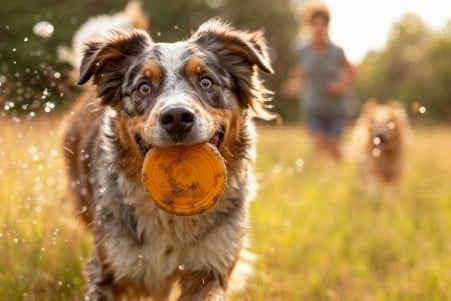Can Dogs Get Abs? A Look at Canine Core Anatomy and Fitness
4 June 2024 • Updated 4 June 2024

If you’ve ever wondered if your dog can get a six-pack, you’re not alone. However, the truth about canine anatomy and muscle structure is a little more complicated. While dogs don’t have the defined, visible “ab” muscles that humans do, their core muscles are still essential for running, jumping, and moving around in general. As a result, most dogs have a well-defined abdomen thanks to their muscles and active lifestyles, even if they don’t have a six-pack.
In this article, we’ll delve into anatomical research, observational studies of working dogs, and interviews with veterinary professionals to explain how a dog’s core muscles work and what they look like. Not only will this answer your questions about your furry friend’s fitness potential, but it will also help you better understand the biological adaptations that make dogs nature’s ultimate athletes.
Can dogs get abs?
Canine Abdominal Muscle Anatomy
The core muscles of the dog are made up of several important abdominal muscles - the external oblique, internal oblique, transversus abdominis, and rectus abdominis. Although the rectus abdominis is responsible for the human six-pack, it is not as prominent in dogs. These muscles do, however, compress the abdominal viscera, which is important for breathing, urination, defecation, and parturition.
The external oblique muscle originates from the ribs and inserts along the linea alba, a midline fibrous seam. The internal oblique is oriented at a right angle to the external oblique and attaches to the costal arch and linea alba. The transversus abdominis wraps around the abdomen and connects the ribs to the linea alba. The rectus abdominis runs from the pubis to the sternum along the ventral midline.
In addition to compressing the abdomen, these muscles help flex and laterally bend the vertebral column. Knowing the anatomy and function of these muscles is important for creating effective exercise and conditioning programs to improve a dog's core strength.
Core Strengthening: Dog Exercises and Workouts
Dogs need regular exercise to build and maintain muscle tone. Bella&Toby notes that a dog's core muscles include the abdominal, spinal, and diaphragm muscles, which are necessary for the body to work properly and perform a variety of daily tasks. Core-strengthening exercises such as the sit-stand-down, swimming, paw lifts, and crawling can help build up this important core strength.
In addition, walking on uneven surfaces, inclines, and stairs can help work the core muscles, according to So Much PETential. In fact, all dogs should have a well-rounded core conditioning program that includes exercises like weight shifting, leg lifts, and cavalettis to improve their overall health, stability, and mobility, according to Pointing Dog Journal. A good core-strengthening program can also help reduce the risk of injuries such as osteoarthritis, soft tissue injuries, and back pain.
How to Tell If Your Dog Is at a Healthy Weight and Has Good Muscle Tone
Veterinarians often reference standardized Body Condition Score (BCS) scales to evaluate a dog's weight and muscle tone. The American Kennel Club notes that a dog with an ideal BCS will have a visible waist, easily felt ribs, and a slight abdominal tuck. Dogs that are overweight will have trouble feeling their ribs, and dogs that are underweight will have ribs that stick out.
Keeping an eye on your dog's BCS and muscle tone is important for their overall health and fitness, according to The Farmer's Dog. A dog's muscle tone can be impacted by a variety of factors, including their age, breed, diet, and how much exercise they get. Working with veterinarians and other pet care professionals can help ensure that your dog's muscle tone is where it needs to be based on their individual circumstances.
Diet's Impact on Canine Muscle Growth
A healthy, high-protein diet is important for muscle growth and maintenance in dogs, according to Rogue Pet Science. The amount of fat and carbohydrates in the diet can be adjusted based on the dog's activity level and energy requirements. According to ScienceDirect, dogs can oxidize fat more efficiently than humans, and a high-fat diet can help improve endurance and stamina in activities like sled dog racing.
Nutrition is important for athletic performance, recovery, and overall health. As Onlinepethealth explains, things like stress and gut health can affect the absorption of nutrients and the development of muscle. A veterinarian can help you figure out the best nutrition plan to meet your dog's muscle-building needs.
Breed Differences and Genetic Predispositions
Breed and genetics play a role in a dog's muscle mass. For example, SPARK PAWS notes that pit bulls, particularly the American pit bull terrier, have more muscle mass because they were bred from other muscular breeds like terriers and bulldogs.
Breed differences in muscle anatomy, structure, and composition can also impact muscle development. As the PMC study on working dog structure points out, the anatomy of all dogs is the same, but the way the components are put together for each breed determines their size and shape. This is why the study suggests that a dog's structure, including things like limb angulation and scapular movement, should be taken into account when assessing muscle potential.
That said, regardless of breed, muscle tone can be developed through exercise, diet, and conditioning. In fact, according to Showsight Magazine, it's important to have a team of professionals including canine trainers and veterinarians to ensure that muscle development is maximized based on a dog's breed and individual needs.
Conclusion: Understanding and Optimizing Your Dog's Natural Muscles
Although the Fit to Work (FTW) program was created for working dogs, the exercises in the program can be helpful for all dogs. The FTW program emphasizes core, hind limb, and supporting soft tissue stability by using exercises such as the Posture Sit, Posture Down, and Pivot. These exercises work the spinal extensor muscles, abdominals, hip stabilizers, and lower extremity joints.
In addition, as Today's Veterinary Nurse notes, ischemic compression and positional release can be used to help with myofascial trigger points and muscle spasms. These techniques can also help with pain relief and increasing range of motion. When these manual therapy techniques are combined with targeted exercises, they can be part of a well-rounded conditioning program.
Furthermore, Canine Works lists 16 exercises that dog owners can use to strengthen their dog's core, such as walking on uneven surfaces, swimming, and cushion work. Strengthening a dog's core muscles can help reduce the risk of injury and improve balance, flexibility, and overall performance.


